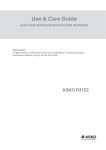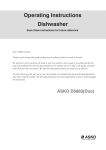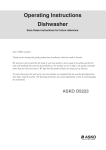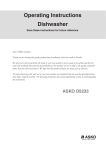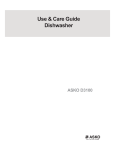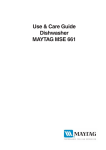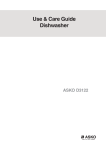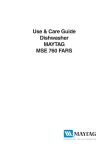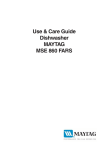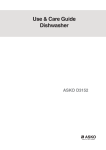Download Asko D5122 Operating instructions
Transcript
Operating Instructions Dishwasher Save these instructions for future reference Dear customer, Thank you for choosing this quality product from ASKO. We hope it will meet all of your expectations and fullfill your needs for many years to come. The Scandinavian design is a combination of clean lines, everyday functionality and high quality. These are the hallmarks for all of our products and this is why they are so highly appreciated all over the world. To get the most out of your new ASKO product, we recommend that you read the installation and operating instructions before using the machine. ASKO D5122 Contents Before doing your first wash 3 Important safety instructions 4 Child safety 5 Parts of the dishwasher* Fragile dishes Cleaning 17 6 Coarse filter Fine filter Drain pump Spray arms Door 17 17 18 19 19 Technical data 6 Rinse aid 20 Baskets* 7 Fault indications 21 Control panel 8 Troubleshooting 22 The dishes are not clean Stains or a film on the china The china has a whitish-blue sticky film Stains on stainless steel or silver Stains which remain after dishwashing Rattling sound during dishwashing The machine will not start Water remains in the machine Bad odour in the machine 22 22 23 23 23 23 23 24 24 Performance information 25 Service and guarantee 26 Quick Guide 28 Detergent Dispenser 8 Basic Course 9 Load the baskets correctly Dishwashing detergent Switch on the main switch Select program Select Option Press start Standby mode 9 9 10 10 Programs 10 11 11 12 Heavy wash Normal wash Quick wash Rinse & Hold Mini Program Guide Program Description 13 Options 14 Temperature selection Drying Eco-dishwashing 2 16 15 Customer Care Center 1-800-898-1879 www.askousa.com Before doing your first wash Read through the directions for use Read through the directions for use before starting to use your machine, especially the Safety, Child Safety, and Basic Course sections. Take care with certain materials Read the Fragile Dishes section before washing china with unglazed decoration or other household goods made of plastic, wood, or crystal requiring careful treatment. Check the door fitting Check that the door of the dishwasher fits properly: open the door a little and let it go. Does it stay exactly where you released it? If not, you should check the installation instructions or consult the installer. Check the water’s hardness Call your local water utility company to check the water hardness in your area. This is important when dispensing dishwasher detergent and rinse aid. Note! Do you need this Use & Care Guide in Spanish? Visit www.askousa.com/customercare to download. ¿ Necesita esta Instrucciones de uso y cuidado en español? Entre en www.askousa.com/customercare y descárguesela. Customer Care Center 1-800-898-1879 www.askousa.com 3 Important safety instructions This manual does not cover all possible conditions and situations that may occur. Common sense and caution should always be used when installing, operating, and maintaining any appliance. • Read all instructions before using the dishwasher. • Dishwashers must be electrically grounded. Read the Installation Instructions for details. • Use the dishwasher only for its intended purpose. • Do not run the dishwasher while you are out of the home. • Use only automatic dishwasher detergents and rinse agents. • To reduce the risk of injury, keep detergents and rinse aids out of the reach of children. • Do not load sharp items near the door; you could damage the door seal. • Place sharp knives in the silverware basket with the sharp ends down to avoid the risk of cut-type injuries. • Do not wash plastic items unless they are marked “dishwasher safe” or the equivalent. For items not marked, check the manufacturer’s recommendations. Items not dishwasher safe could become deformed or melt and create a potential fire hazard. • Do not touch the heating element during or imediately after use. • Do not operate the dishwasher unless all enclosure panels are properly in place (i.e., guard plate, access panel, toe kick, etc.) • Do not tamper with controls by removing or changing. • Do not abuse, sit on, or stand on the dishwasher door or baskets . • To reduce the risk of injury, do not allow children to play in or on a dishwasher. • Under certain conditions, hydrogen gas may be produced in a hot water system that has not been used for two weeks or more. HYDROGEN GAS IS EXPLOSIVE. If the hot water system has not been used for two weeks, before using the dishwasher turn on all hot water faucets and let the water flow from each for several minutes. This will release any accumulated hydrogen gas. As the gas is flammable, do not smoke or use an open flame during this time. 4 • When removing an old dishwasher from service or discarding it, remove the door to the washing compartment. • Do not store or use combustible materials, gasoline, or other flammable vapors and liquids in the vicinity of this or any other appliance. • Disconnect the electrical power to the dishwasher before servicing. • Repairs should be done by a qualified technician. Customer Care Center 1-800-898-1879 www.askousa.com Child safety Child safety tips Dishwasher detergents and rinse aids are corrosive, so always keep them out of reach of children. • Should a child swallow dishwasher detergent or rinse aid, give plenty to drink immediately, i.e., one or two glasses of milk or water. Do not try to induce vomiting. Seek medical advice immediately: Call the National Capital Poison Center at 1-800-222-1222 • Always close the door and start the dishwasher as soon as you put in the detergent. • Always keep small children away from the machine when it is open. There may be some detergent residue left inside the machine. • If dishwasher detergent gets in someone’s eyes, rinse them with plenty of water for at least 15 minutes. • Do not allow children to use or play in or on the dishwasher. • Load all long and sharp items in the knife/ utensil basket. If this is not possible, load sharp objects with the pointed end facing the back of the dishwasher. Sharp items loaded in the silverware basket should be loaded with pointed ends down. • Engage the child safety lock. Engaging the Child Safety Lock This model has a child safety lock on the left of the door handle. To activate the lock, press in the door handle and use a screwdriver to turn the screw slot to a vertical position. Reset it by turning the slot to its horizontal position. To open the door when the safety lock is engaged, press the white plastic tab located to the left of the door handle toward the left and hold it as you lift the door handle. (See illustration at below.) Customer Care Center 1-800-898-1879 www.askousa.com 5 Parts of the dishwasher* 1. Upper basket 2. Spray arms 3. Cutlery basket 4. Lower basket 5. Dishwasher detergent compartment 6. Main power switch 7. Rinse Aid Compartment 8. Filter 9. Serial tag and rating plate 1 2 33 4 5 *Details may differ depending on the model and market! 6 8 7 Technical data Height Width Depth Weight Water pressure Connection Max output 6 34-3/8” - 36-1/2” 874-927mm 24” (610)mm 24” (610mm) 105.8 lbs (48 kg) 4.2 - 140 psi 0.03 - 1.0 MPa 0.3-10 Bar Single phase, 120 V, 60 Hz, 10 A 1300 W Customer Care Center 1-800-898-1879 www.askousa.com 9 Baskets* 1. Wine glass shelf 2. Cup rack 3. Knife stop 4. Cutlery basket with door and folding handle Upper basket 2 1 3 Lower basket Cutlery basket 4 *Details may differ depending on the model and market! Customer Care Center 1-800-898-1879 www.askousa.com 7 Control panel 3 4 1 8 2 5 PROGRAM S TA R T STOP 7 6 1. Program selector 2. Heavy wash 3. Normal wash 4. Quick wash 5. Rinse & Hold 6. Normal temperature 7. Normal dry 8. Start/stop Detergent Dispenser 1 2 3 1. Compartment for main wash dishwasher detergent 2. Compartment for pre-wash detergent 3. Refill indicator rinse aid 4. Rinse aid cover 5. Detergent compartment cover 4 5 8 Customer Care Center 1-800-898-1879 www.askousa.com Basic Course Below are step-by-step instructions to help you achieve the best possible dishwashing results. Load the baskets correctly! Thanks to Self Cleaning System, you do not need to rinse the dishes under running water. Simply remove large food particles and debris. Convenient and environmentally-friendly! Place glasses, cups, bowls, side plates, and saucers in the upper basket. Wine glasses should be hung from or leaned against the wine glass shelf and knives placed in the knife stand if present. The cutlery basket has a folding flap in the middle for small items or narrow shafts, such as electric whisks. Place long cutlery and carving knives in the special knife box (if present) or in the upper basket. Check that the spray arms are able to move freely. See the section entitled Fragile Dishes if you want to wash objects that may be fragile. Note! Ensure that all soiled surfaces face inwards or downwards! Place dinner plates, side plates, serving dishes, saucepans, and cutlery (in the cutlery basket) in the lower basket. The removable plate insert, which comes with certain models, can be easily removed to provide room for large plates, saucepans, and pots, or placed in three alternative positions. Stand the cutlery with handles downward and as spread out as possible. Ensure that spoons are not resting inside each other. Dishwashing detergent We recommend that you use only unscented, granular automatic dishwashing detergent. Using the wrong detergent could cause flooding and/or damage your dishwasher. Do not use detergent that has been wet and is clumped. Also, check the expiration date on the container. The amount of detergent needed can vary due to differences in water hardness. To determine the water hardness in your area, contact your local water utility or area water softening company. The harder the water, the more detergent you may need. Refer to the chart below for the recommended detergent amounts based on water hardness. Remember, you should adjust the amount of detergent you use by small amounts until you find the correct amount. Do not put cutlery made of different materials - such as silver and stainless steel - in the same compartment (risk of stains). Customer Care Center 1-800-898-1879 www.askousa.com 9 Twelve grains and higher is extremely hard water and detergent alone may not be enough. You may need to use a water softener to maximize the performance of your dishwasher. Also, in areas with hard water (9+) you may need to wash at lower temperatures to prevent hard water deposits from forming in tank and wash system. In hard water areas, both the dishes and the machine can develop a white or gray film after a while. This can be removed by replacing the prewash detergent with two tablespoons of citric acid. If the water is very hard, use a rinse aid that contains citric acid. Different brands of dishwasher detergent have different amounts of phosphorous for softening water. If you have hard water and use a detergent with less than 8.7% phosphorous content, you may need to use more detergent or use a detergent with more than 8.7% phosphorous content. NOTE: We recommend that you do not add prewash detergent for the Quick wash programs. NOTE: If you use a dishwashing detergent with a rinse aid additive, you should not fill the rinse aid dispenser. This could cause a film on your dishes. Dishwasher tablets Halve the tablet if it is difficult to close the dispenser cover. There is a risk that the dishwasher detergent will not break down properly to give the correct dosage if the cover is tight and cannot be opened correctly. 3-in-1/ Multi-purpose detergent Note! Read the directions for use for such products carefully. If anything is unclear, contact the detergent manufacturer. Switch on the main switch Select program For select program see Part Programs. Select Option If you wish to use additional options, continue Part Options. Otherwise you can now start the machine, see point 6. Recommended detergent amounts based on water hardness Water hardness Detergent amounts Soft Prewash 1 teaspoon (0-3 grains per gallon) Main wash 1 to 1-1/2 tablespoons Medium Prewash 1 teaspoon (4-8 grains per gallon) Main wash 1 to 2 tablespoons hard Prewash 1 teaspoon (9+ grains*) Main wash 2 to 3 tablespoons * 12 grains and higher is extremely hard water. 10 Customer Care Center 1-800-898-1879 www.askousa.com Press start The dishwasher will now start. It manages the entire wash automatically. Ensure that the door is properly closed or the machine will not start. The display shows ‘Program started’. If the door is open or not properly closed, ‘Close door’ appears in the display. Changing program If you wish to change the program after having started the machine, press the Start/ Stop button for three seconds. Then select a new program and press the Start/Stop button again. 7 Standby mode Once the machine has finished, it is drawing a very small amount of power. Disconnect the power by switch off at the main switch. Turn off the water tap if the machine is not to be used for an extended period, e.g. during holidays. The indicators around the Start/Stop field gradually light up as the programme progresses. When the programme finishes, all the indicators are lit, turning off 2 hours later. Do you want to load more dishes? Carefully open the door; the machine will stops automatically, put in the dishes, close the door and the dishwasher will continue from where it left off. If the machine is switched off at the main switch (or in the event of a power cut) before the washing program has been completed, the interrupted program will continue when the power comes back on. NB! If the power is switched off, or if the door is open during drying, the program is interrupted. Customer Care Center 1-800-898-1879 www.askousa.com 11 Programs Select a program by pressing the program selector one or more times until the required program symbol lights up. See the Program guide below. Heavy wash The Heavy Wash program should be used for heavily soiled dishes, e.g. saucepans, pots and gratin dishes. If there is still space in the machine after loading such items, you can add plates etc. Normal wash Used for washing normally soiled dishes such as plates, serving dishes, cups and glasses, etc. Note! For washing normally soiled mixed loads with use the Normal wash program normal temperature and normal drying . To save more water and energy use economy temperature and economy drying. Quick wash Select Quick Wash if the dishes are very lightly soiled. This program is used for very lightly soiled glass and china, e.g. coffee cups. Rinse & Hold For rinsing the dishes while waiting for the machine to be filled. 12 Customer Care Center 1-800-898-1879 www.askousa.com Program Description Programview Programs Heavy Program info For heavily soiled loads, such as pots, pans, casseroles, etc. Normal Quick Rinse & Hold For normally soiled loads such as plates, glasses, bowls, and lightly soiled pans. For lightly soiled loads that are washed immediately after use. This program can also be used for delicate items. To rinse dishes that you plan to wash later that day. -- Options Prewashes with SCS* 2 prewashes 2 prewashes -- -- Mainwash *** 160°F 150°F 140°F -- Number of rinses 3, last rinse 160°F 2, last rinse 160°F 2, last rinse 140°F 1 rinse Consumption values 1. Wash time hot water / min. ** 205 150 60 4 Energy approx. kWh 1.1 0.9 0.7 0.01 2.Wash time cold water / min.** 240 190 80 4 Energy approx. kWh 1.8 1.7 1.1 0.01 Water consumption (gallon) 5.0 5.5 2.5 0.8 SCS = Self Cleaning System. ** All quoted times are approximate. Cycle time fluctuations may occur due to water temperature, water pressure, variations in voltage etc. 1. Hot water connection approx. 50°C (120°F). 2. Cold water connection approx. 10°C (50°F). *** The listed temperatures are set as the default from the factory. You can alter the program temperature by choosing the temperature options in the chart on page 14. Customer Care Center 1-800-898-1879 www.askousa.com 13 Options Select options To select an option, press one of the option buttons. Temperature selection * With the temperature option button you can select the wash temperature yourself. You can vary the temperatures as follows: Normal Economy Heavy: Normal: Quick: 160°F (70°C) 130°F (55°C) 150°F (65°C) 130°F (55°C) 140°F (60°C) 85°F (30°C) The field next to the button lights up if you have selected the normal temperature. The selection remains until a change is made. Drying * If you require a better drying result, you can press the Normal drying button. The field next to the button lights up. Should you require a programme with Economy drying – press again and the light will go out. * Cannot be used in the Rinse & Hold programme. 14 Customer Care Center 1-800-898-1879 www.askousa.com Eco-dishwashing Only wash full loads Waiting to run the wash until the machine is full saves energy. Wash at a lower temperature If the dishes are only lightly soiled you can run a Quick wash program and reduce the temperature to 86°F (30°C). Select a program with Economy dry To save energy, select Economy dry. You will get a better drying result if you leave the door slightly open after the end of the program. Do not rinse before dishwashing Thanks to the dishwasher’s Self Cleaning System you do not need to rinse the dishes under running water before loading them into the machine. Choose environmentally-friendly dishwasher detergent Read environmental declarations on the package! Reduce Energy Use You can use a cold water fill which can save additional energy. The dishwasher heats water which is used for the main wash and final rinse. Customer Care Center 1-800-898-1879 www.askousa.com 15 Fragile dishes A number of household goods are not suitable for machine washing. This can be due to a variety of reasons. Certain materials cannot withstand intense heat; others can be damaged by the dishwasher detergent. Fragile decoration China with decoration on top of the glaze (the goods have a rough feel) should not be machine washed. Plastic Certain types of plastic cannot withstand the high temperature generated in machine dishwashing. Protect plastic goods Select a program with a low temperature. Crystal/ glass Place the goods so that they do not knock together during the wash. Use the lowest possible wash temperature and the shortest possible program. Do not heat dry! Antique and very fragile items should not be machine washed. Glass which is machine washed at high temperatures can in time develop a grey film which cannot be removed. Wash fine glass at the lowest temperature and with a low dosage of dishwasher detergent. Silver Silver and stainless steel items should not come into contact with each other as the silver can discolor. Cutlery with glued handles Certain types of adhesive cannot withstand machine washing. In such cases the handles can come loose. Wood Wooden items should only be machine washed if they are labeled as dishwasher safe. Aluminum Aluminum can be dulled by machine washing. However, good quality aluminum saucepans can be machine washed, although a reduction in luster should be expected. 16 Customer Care Center 1-800-898-1879 www.askousa.com Cleaning Spray arm The dishwasher’s inner container is made of stainless steel and is kept clean through normal use. However, if you have calciferous (hard) water, lime deposits can form in the dishwasher. In this case, run a normal wash program with two tablespoons of citric acid in the dishwasher detergent compartment. Coarse filter Fine filter Tubular strainer Coarse filter The coarse filter collects large food particles which cannot get past the outflow pump. Empty the coarse filter if necessary. 1. Lift the coarse filter by the handle. 2. Empty the coarse filter. Remember to replace the filter! Fine filter Debris that collects on the fine filter is automatically rinsed away during each programme. However, the fine filter and its pipe section should be cleaned once or twice a year. 1. Turn the handle once anticlockwise. 1x Customer Care Center 1-800-898-1879 www.askousa.com 17 2. Lift the coarse filter and the pipe section straight up by the handle. 3. Remove the fine filter. 4. Clean the fine filter and the pipe section with a washing-up brush. Replace in reverse order. Make sure the edges seal properly when replacing the fine filter. Drain pump The pump can be accessed from inside the machine. VARNING! Always unplug the dishwasher or turn the power to the unit off at the circuit breaker before cleaning the pump. 1.Loosen the coarse filter by turning it anti clockwise once and remove the fine filter. 2. Remove the pump access plug to the left in the bottom drain. 3. By inserting a finger into the hole you can rotate the pump blade and remove any blockages. 4. Replace the Pump access plug and filters. 5. Insert the electrical plug back into the outlet. 18 Customer Care Center 1-800-898-1879 www.askousa.com If you still cannot start the machine and a humming noise can be heard, then the overfilling protection has been activated. • Shutoff the water • Remove the plug from the wall socket • Call Service CAUTION! Do not forget to replace the small pump access plug. Spray arms The holes and bearings can occasionally become clogged. 1. Pull the lower spray arm straight up to release it. 2. Scrape away the debris with a needle or similar. The spray arms also have holes on the underside. To release the upper spray arm, the upper basket must be removed. 3. Pull out the basket and turn the basket stop outwards on both rails (see picture). The basket can now be removed. 4. Remove the upper spray arm in the same way as the lower arm and clean it. Door When cleaning the edge around the door, use only a slightly damp cloth, possibly with a little detergent. Do not use a spray bottle or similar around the door catch. This is to ensure that water does not penetrate into the door catch and come into contact with the electrical components. CAUTION! Do not use a spray bottle or similar around the door catch. Tip! In order to prevent bad odours in the dishwasher, clean the strips and corners with a dish brush and low-lather detergent. Customer Care Center 1-800-898-1879 www.askousa.com 19 Rinse aid Adding rinse aid In some cases, drying can be made more efficient by using rinse aid. To fill with rinse aid: 1. Turn and lift up the cover of the rinse aid compartment to the right of the dispenser. This is where you top up and set the amount of rinse aid to be dispensed in each wash. 2. Carefully pour in rinse aid up to the dosage setting knob. Alter dosage if required. Do not forget to close the cover. Machines with refill indicator There is a refill indicator in the middle of the dispenser (see illustration). If the refill indicator is totally black, there is sufficient rinse aid. However, if the indicator has a more transparent appearance, you need to fill up with rinse aid (see above). Select dosage The dispenser is usually set at 1= soft water. However, depending on the water hardness, you may need to change the dosage. Open the rinse aid cover. Here you will find the dispenser’s adjustment dial. Settings 1-6: the harder the water, the higher the dosage. When the water hardness exceeds 3 grains, you should use rinse aid with citric acid (acid rinse aid). Too much rinse aid can lead to the buildup of foam. If your water is particularly soft, you can dilute the rinse aid (1 part rinse aid, 1 part water). Too much rinse aid can cause streaks on the dishes, while too little can result in water stains. Open Refill indicator Closed Cover for rinse aid Open by turning and lifting the cover! 20 Customer Care Center 1-800-898-1879 www.askousa.com Fault indications Indication Type of fault L2 flashing L2 Action Too much water in the dishwasher Phone service L3 L12 L1 L7 L4 PROGRAM S1 S3 L6 L11 L8 S TA R T STOP S2 S4 L5 L10 L9 Customer Care Center 1-800-898-1879 www.askousa.com 21 Troubleshooting Problems Possible causes Action The dishes are not clean • The spray arms are not rotating. • Lift off the arms and clean. • Old dishwasher detergent. NB! Detergent is a perishable. • Avoid large packs. • Incorrect dosage of detergent. • Dispense according to the level of water hardness. • Insufficiently powerful dishwashing program. • Change to a more intensive program. • Incorrect loading of the dishwasher. • Do not cover china with large bowls or similar. • Glasses and cups have tipped over during the wash. • Load the china securely. • Incorrectly set rinse aid dispenser. • See the chapter on rinse aid. • Phosphate-free detergent in combination with hard water. • Change detergent. • Too high a temperature and/or too much detergent can cause etching on (crystal) glass. Unfortunately this cannot be remedied, only prevented! • Wash (crystal) glass at a low temperature and dispense dishwasher detergent with care. Contact the dishwasher detergent manufacturer. Stains or a film on the china • Use liquid detergents on fine china. 22 Customer Care Center 1-800-898-1879 www.askousa.com Problems Possible causes Action The china has a whitishblue sticky film • Too high dosage of rinse aid. • Reduce dosage. See the chapter on rinse aid. If the water is very soft, you could try diluting the rinse aid (1 part rinse aid, 1 part water). Stains on stainless steel or silver • Certain food remnants such as mustard, mayonnaise, lemon, vinager, salt and dressings can cause stains on stainless steel if allowed to remain for any length of time. All stainless steel can mark silver if allowed to come into contact during the dishwashing process. Aluminium can also cause stains on dishes. • Rinse off food residue of this type if you do not intend to start the dishwasher immediately. Stains which remain after dishwashing • Lipstick and tea can be difficult to remove. • Change to a detergent with bleach. Rattling sound during dishwashing • The dishes are not properly loaded or the spray arms are not rotating. • Check that the china is loaded securely. Spin the spray arms to make sure that they rotate. The machine will not start • You have forgotten to switch on the main switch. • Check • The door is not properly closed. • Check • A fuse has blown. • Check • The plug is not plugged in. • Check • The water tap is off. • Check • Seperate your cutlery into various compartments in the basket. Make sure silver and stainless steel are not together. • Overfilling/leakage To restart the machine, press Start/stop for 3 seconds. Now select a new programme and press Start/stop. • A droning sound (drainage pump) can be heard from the machine, this does not stop when the power is switched off using the main power switch. Customer Care Center 1-800-898-1879 www.askousa.com 1. Close the water tap. 2. Pull out the plug. 3. Call a service engineer 23 Problems Possible causes Action Water remains in the machine • Obstruction in the drain hose. • Disconnect the drain hose where it is connected to the sink’s water trap. Check that no debris has become stuck. Is the cone-shaped part of the pipe cut so that the diameter is at least 16 mm? • Kinks in the drain hose. • Check that the hose is free from kinks or sharp bends. • The filters are clogged. • Clean out the coarse filter, the fine filter and the filter. • Objects in the drain pump. • Clean out the drain pump. See chapter on cleaning • Dirt along the strips and in corners • Clean with a dish brush and low-lather detergent. Bad odour in the machine 24 Customer Care Center 1-800-898-1879 www.askousa.com Performance information Energy standard USA: ANSI/AHAM DW-1-2005 Technical data Height: Width: Depth: Weight: Water pressure 34-3/8” - 36-1/2” 874-927mm 24” (610mm) 24” (610mm) 105.8 lbs (48 kg)* 4.2 - 140 psi 0.03 - 1.0 MPa 0.3-10(Bar) See serial tag/rating plate See serial tag/rating plate Electrical connection: Rated power: *The weight can vary due to varying specifications. Loading of performance test Upper basket with 10 place settings AHAM DW-1 Lower basket with 10 place settings AHAM DW-1 Customer Care Center 1-800-898-1879 www.askousa.com 25 Service and guarantee Asko Appliances Inc. will not pay for: 1. Service calls to: • Correct the installation of the appliance. • Repair damage due to shipment, delivery, installation, misuse or abuse. • Instruct how to use the appliance. • Replace house fuses or correct house wiring. • Correct house plumbing, including drainage problems related to improper installation. • Clean or service air device in drain line. 2. Repair and/or replacement parts for failure of product if appliance is used for other than home/residential use. 3. Damage resulting from accident, fire, floods, acts of God, alteration, misuse, abuse, improper installation, or installation not in accordance with local electrical or plumbing codes. 4. Any shipping costs for parts during the limited warranty period. 5. Replacement parts or repair labor costs for units operated outside the continental United States. 6. Pickup and delivery. ASKO washers are designed to be repaired in the home. In no event shall Asko Appliances Inc. be responsible for any incidental or consequential damages. Some states will not allow the exclusion or limitation of incidental or consequential damages, so this exclusion or limitation may not apply to you. This warranty gives you specific legal rights and you may also have other rights which vary from state to state. It is important to register your product warranty by logging onto www.askousa.com/customercare/registration and filling out all required fields within 90 days from the date of purchase. After doing so, you will be e-mailed a certificate that will extend the original warranty for one additional year. If you do not have access to the in ternet, complete the warranty card included with the product and mail it to the address on the warranty card within 90 days of the date of purchase. Cosmetic damage must be repor ted to your dealer within five days from the date of purchase. After unpacking the washer, thoroughly check the unit for cosmetic damage. 26 For residential installations only Asko Appliances Inc. will pay for: Length of warranty Two-Year Full From date of purchase. ASKO replacement parts and/or repair labor to correct defect in materials or workmanship. Service must be provided by an authorized ASKO service agent. Third year full Complete your product warranty registration online at www.askousa.com/customercare/registration within 90 days from the date of purchase to extend the original warranty one additional year. If you do not have access to the internet, complete the warranty card included with the product and mail it to the address on the warranty card within 90 days of the date of purchase. ASKO replacement parts and/or repair labor to correct defect in materials or workmanship. Service must be performed by an authorized ASKO service agent. Customer Care Center 1-800-898-1879 www.askousa.com For residential installations only Asko Appliances Inc. will pay for: Lifetime ASKO replacement parts (labor cost not included) for the stainless steel tank if it exhibits a manufacturing defect such as cracking or rusting through. Service must be provided by an authorized ASKO service agent. ASKO replacement parts and/or repair labor to correct defect in materials or workmanship. Service must be provided by an authorized ASKO service agent. For non-residential installations One-year Full Warranty from date of purchase. For warranty service, contact our Customer Care Center at the number listed below. Before calling for service or contacting Asko Appliances Inc. regarding a warranty issue, make a note of the model, type name, and serial number. Write to us at: Asko Appliances Inc. P. O. Box 851805 Richardson, Texas 75085-1805 www.askousa.com Or contact our Customer Care Center at 1-800-898-1879 www.askousa.com Customer Care Center 1-800-898-1879 www.askousa.com 27 Quick Guide 1. Load the baskets correctly! Thanks to the Self Cleaning System you don’t need to rinse the dishes, simply scrape large food particles and debris. 2. Dispensing dishwasher detergent The detergent compartment has a small compartment for pre-wash and one for main wash. 3. Ensure that the spray arms can rotate freely 4. Turn on the main power switch 5. Close the door 6. Select the program and press start For normally soiled dishes, use the Normal Wash program with Normal temperature Normal drying . To save more water and energy use Economy temperature and Economy dry. and Mini Program Guide Programview Programs Heavy Program info For heavily soiled loads, such as pots, pans, casseroles, etc. Normal Quick Rinse & Hold For normally soiled loads such as plates, glasses, bowls, and lightly soiled pans. For lightly soiled loads that are washed immediately after use. This program can also be used for delicate items. To rinse dishes that you plan to wash later that day. -- Options Prewashes with SCS* 2 prewashes 2 prewashes -- -- Mainwash *** 160°F 150°F 140°F -- Number of rinses 3, last rinse 160°F 2, last rinse 160°F 2, last rinse 140°F 1 rinse Item No.: 80 820 07 Rev. 01 We reserve the right to make changes. Printed on environmentally-friendly paper that meets the demands of Friends of the Earth and the Swedish Society for Nature Conservation. 28 Customer Care Center 1-800-898-1879 www.askousa.com




























